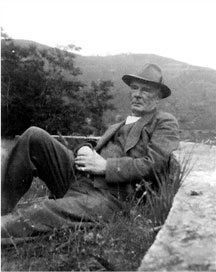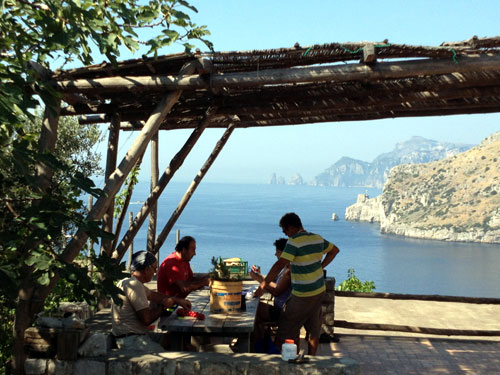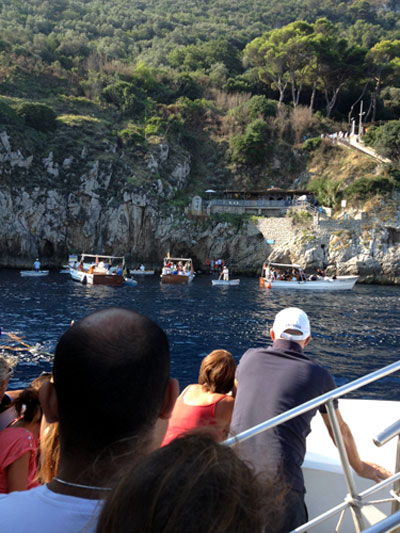|
"How hard it is, sometimes, to trust the evidence of one's senses! How reluctantly the mind consents to reality."
― Norman Douglas
In early September 2013, the Steiny Road Poet, along with some of her best friends, had the occasion to walk past the gate of the villa where Norman Douglas in 1908 began drafting his first book Siren Land. It's no small thing to get to this gate because it is located on a billy goat trail along the Sorrento coast. From this lofty ridge, one can see the rock islands known as Li Galli Islands and also called by the locals The Sirens. According to Greek legend, Gallo Lungo, Rotonda, and Castelletto were the homes of the sirens that tempted Odysseus as he tried to make his way home to his family.
Douglas was known to Gertrude Stein through her dear friend Carl Van Vechten. Evidence of this appears in a photo postcard sent from Van Vechten to Stein November 5, 1936 in which Douglas and Van Vechten were photographed in the Cascine Gardens of Florence, Italy.
The Steiny Road Poet conjectures that Stein would not have been a fan of Douglas.  His writing was complicated, ornate, and filled with classical illusions unlike Stein's, which was pitched to the ordinary person with simple Anglo-Saxon words and rare allusions of any type. To his credit, Douglas begins Siren Land with a fairly simple statement that contains a question: "It was the Emperor Tiberius who startled his grammarians with the question, what songs the Sirens sang?" The closing sentence of that first paragraph is: "The grammarians, if they were prudent, doubtless referred him to Homer, who has preserved a portion of their lay." Simply put, Douglas suggests that the scholars of Tiberius would have pointed their emperor to the poet Homer, author of the Odyssey, who recorded some of the Siren songs. His writing was complicated, ornate, and filled with classical illusions unlike Stein's, which was pitched to the ordinary person with simple Anglo-Saxon words and rare allusions of any type. To his credit, Douglas begins Siren Land with a fairly simple statement that contains a question: "It was the Emperor Tiberius who startled his grammarians with the question, what songs the Sirens sang?" The closing sentence of that first paragraph is: "The grammarians, if they were prudent, doubtless referred him to Homer, who has preserved a portion of their lay." Simply put, Douglas suggests that the scholars of Tiberius would have pointed their emperor to the poet Homer, author of the Odyssey, who recorded some of the Siren songs.
Further along in "Sirens and Their Ancestry," the first chapter of Siren Land, is this explanation:
…The Odyssey, which sweeps along its current the legend-wrecks of multitudinous extra-Hellenic races, has wafted down to us a fragment of the foreign and cannibalistic old Siren-lore---
In verdant meads they sport, and wide around
Lie human bones, that whiten all the ground;
The ground polluted floats with human gore,
And human carnage taints the dreadful shore....
but there is no further elaboration of this ungracious aspect; on the contrary, their song, which follows, is conceived in the true spirit of beauty and quite at variance with this primeval picture of crude bloodthirstiness.
In 2010, Siren Land was reissued with the subtitle: "A Celebration of Life in Southern Italy." Considered by some as the father of modern travel literature, Douglas, despite his erudition, continues to be surprisingly in tune with contemporary thinking. Consider this passage taken from the first paragraph of Chapter V "The Philosophy of the Blue Grotto":
And yonder goes the steamer conveying six hundred foreigners for their day's visit to Capri and its celebrated Blue Grotto. Unhappy mortals! They are packed like sheep, although they have paid untold sums for their tickets.

Walking along the ridge from the Douglas villa, a hiker will get to a vista of the Isle of Capri, an enchanting destination for anyone lucky enough to be in the Naples-Sorrento neighborhood. The Steiny Road Poet has visited Capri three times and each time she has been admonished to forego a visit to the Blue Grotto because it is a time- and money-waster frequented these days to a large degree by madding crowds that arrive on cruise liners. The skinny is that you stand in line for hours, pay your money, then lie down in the bottom of a boat and your boat is inserted into the cave (grotto) for a minute and that's the whole experience! Usually the visitor feels robbed. The Steiny Poet did not know that Norman Douglas recorded this counsel about avoiding the blue grotto at the beginning of the 1900s. The lure of this particular grotto is very strong and the Steiny Poet let it into her poem written on her first trip to Italy and Capri.
 |
CANTO DI CAPRI
The cock crows. I awake facing the sea
from Capri. Emotion like Italian
conversation comes up like the sun,
rising. Last night, thunder
cracked over the sea lighting
the way to Africa; I could walk
on air, a Madonna floating
above the hillside chapel ascending
to Anacapri. My dreams
and days are colored with magenta
of bougainvillea -- flowers, flowers,
flowers and men singing unabashedly
the canzoni d'amore. Despite the winds
that whisper winter, why should I go
home? I'll live in a grotto furnished
with blue coral, cover myself with lilies,
dine on calamari, and smile forever
like a slice of the moon.
Karren LaLonde Alenier
Around the Sorrento coastline is a fishing village known as Crapolla, a name Americans find exceedingly funny because it sounds so scatological. Gertrude Stein would have probably found Douglas' discussion on the names of places around the Sorrento coast intriguing since names were so important to her.
The name Crapolla has been derived from "akron Apollinis," as though a temple of Apollo had stood here. But this is pure Cicerone-etymology--the origin of the word is the same as that of Capri, and in old deeds it is actually called Capreola. What Capri means is not quite certain; it is neither Greek nor Phoenician; there are places with similar names all over Italy and half a dozen Capri's and Caprile's within a few miles of here. Quaranta deduces it from a Tyrrhenian root signifying rocky or stony. Why not? When, nearly two centuries ago, Greek etymology could no longer explain all local names and traditions, the enlightened took refuge in Semiticism, and thus there grew up the ponderous Shem-Ham-and-Japheth literature of Martorelli and his disciples, which we have outgrown in its turn. Nowadays, the conveniently obscure Tyrrhenian language helps to solve old difficulties. But it makes new ones.
This Cicerone-etymology which has infected the whole of this region--the whole of Italy, in fact--is a legacy left us by the a priori scholarship of past generations which worked with fixed ideas: it was pleasant to make learned assertions, and to believe is always easier than to doubt or to deny. There is Nerano, for instance, which has become fancifully connected with Nero--"Re Nerone" they call him--who plays approximately the same part here as Tiberius does at Capri. These are his baths; yonder, in those caverns, were celebrated the orgies of which we have all heard. There are three of these caverns under the crag of Mount San Costanzo; the largest, a noble grot, distils limpid water, which is collected into a small reservoir. In one of these three lies the treasure, a golden statue of a child, but only one man had the book, and that was the old hermit of Capri who promised over and over again to come and perform the necessary adjurations, but somehow or other never kept his word; and now he is dead. He was the last person whom the Caprioles would have suspected of being versed in necromancy, an ex-shoemaker and a great simpleton, but the men of Nerano knew better: a prophet is of no account in his own country.
So having stayed in a villa high atop the Marina del Cantone, a stony beach with quiet blue waters filled with little boats that is part of Nerano, the Steiny Road Poet has definitely fallen under the sway of Douglas' pen. She leaves you, Dear Reader, with these words from the last page of Siren Land, "What you cannot find on earth is not worth seeking. The Steiny Road Poet was left pinching herself about the breath-taking beauty of the place. Definitely imbued with the call of Sirens.
|





